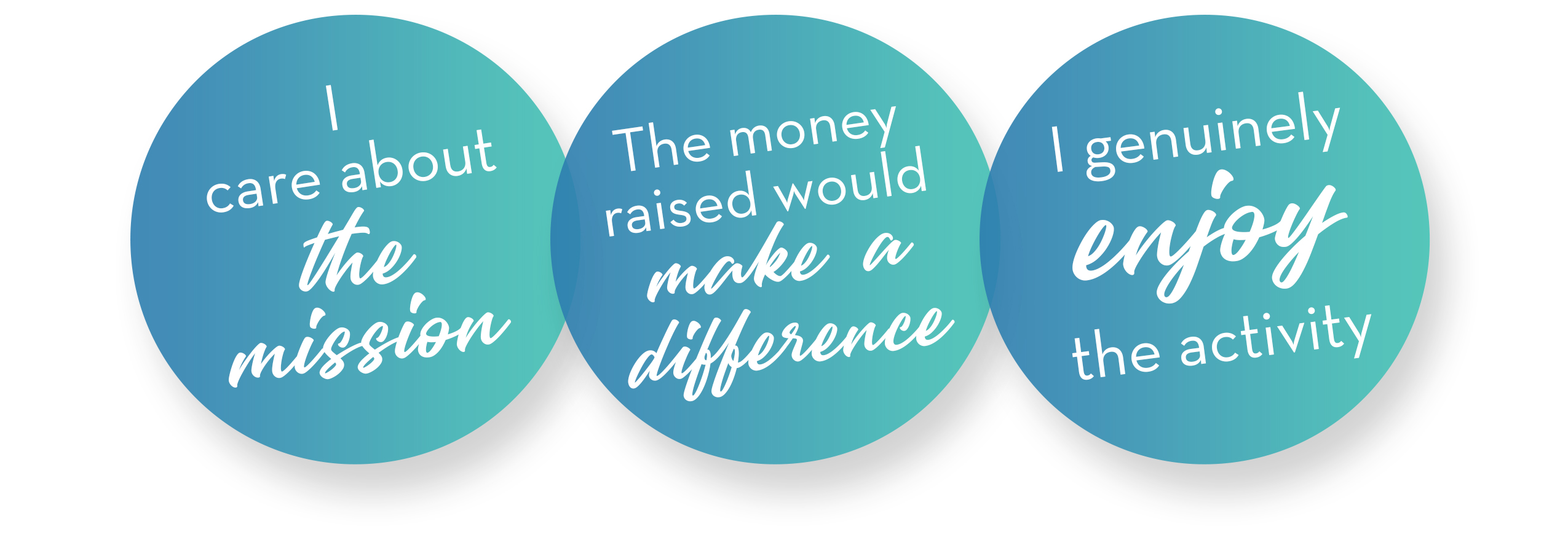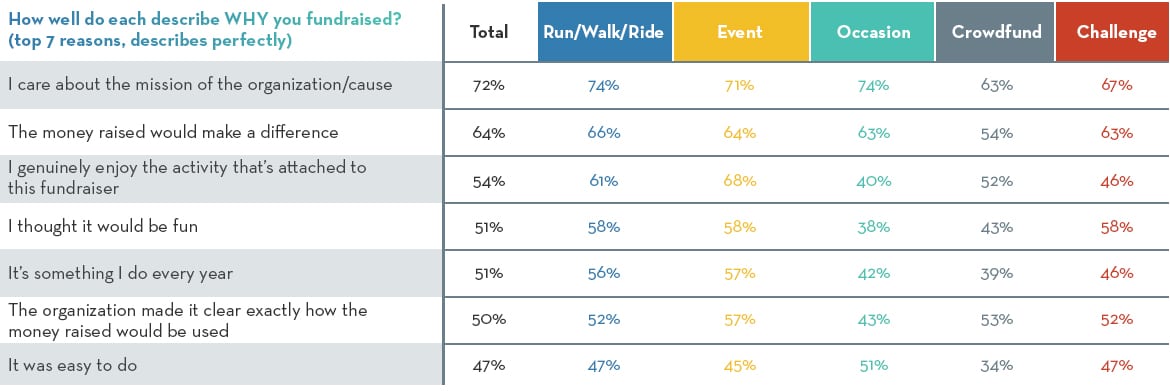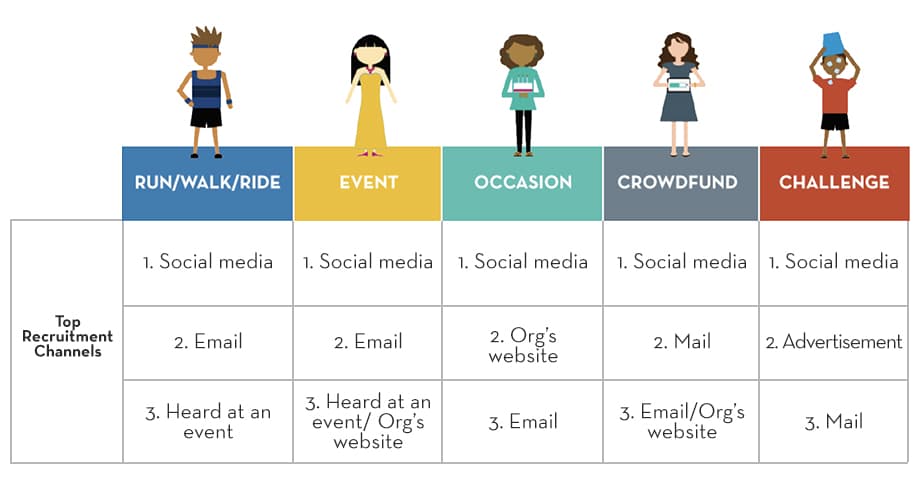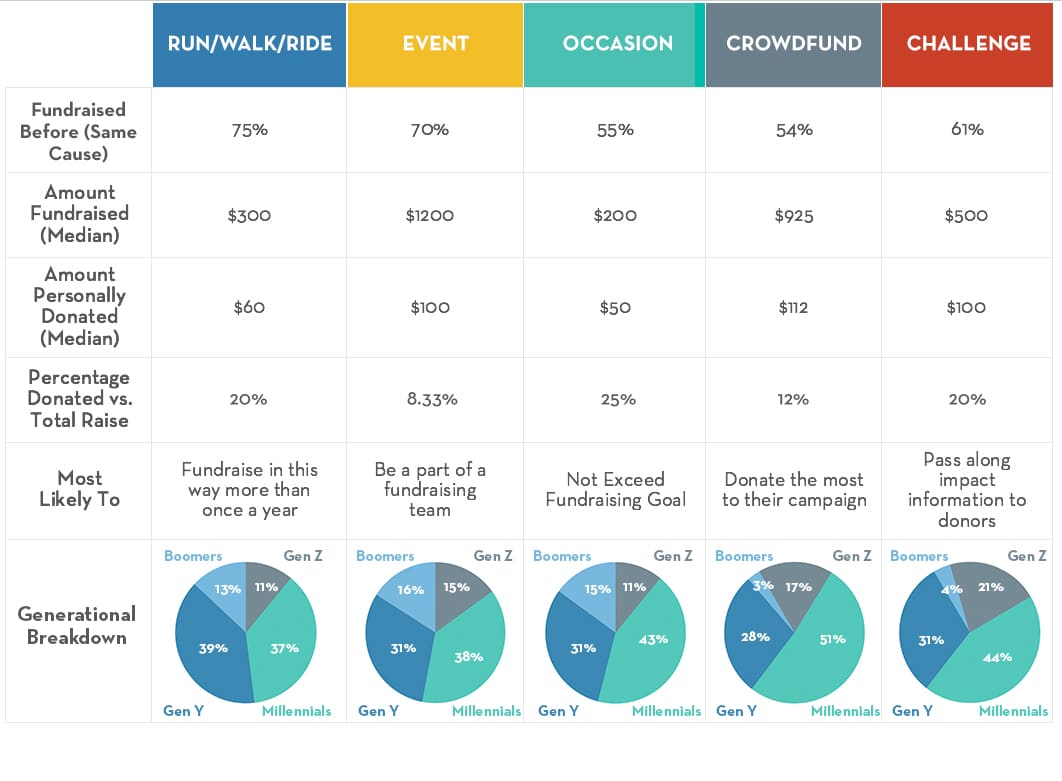Today’s Social Fundraisers: What You Need to Know
The world of peer-to-peer fundraising is evolving fast. Today’s participants expect a different experience than those fundraising a decade ago, and nonprofits know that individual social fundraisers are the lifeblood of their success.
What is the mindset and motivators of today’s peer-to-peer participants? Who are they?
We set out to survey 1,106 of today’s participants, to understand what makes them stick and stick again to a cause.
According to a recent study conducted by OneCause, Social Fundraisers are defined as peer-to-peer participants who fundraise on behalf of a nonprofit, charity, or cause during the last 12 months in one of the following ways:
- Crowdfund: Set up a crowdfunding campaign on behalf of an organization or cause
- Challenge: Participated in a fundraising challenge or virtual campaign (e.g. the ALS Ice Bucket Challenge)
- Event: Hosted, organized, or sponsored a fundraising event
- Occasion: Requested donations for an occasion (e.g. birthday or an in memoriam/tribute)
- Run/Walk/Ride: Participated in a run, walk, ride, or similar activity
Buckle up and enjoy the ride into the exciting world of today’s peer-to-peer participants so that your nonprofit, can better understand how to motivate and keep them.
The top 5 things to know about peer-to-peer participants include:
They Like to Fundraise
Peer-to-peer fundraising participants are regular fundraisers—85 percent say they fundraise at least once a year. Forty-one percent of participants surveyed report social fundraising on behalf of nonprofits more than once a year, with 44 percent participating in a peer-to-peer fundraising campaign annually.
That makes today’s peer-to-peer participants habitual fundraisers, participating in fundraising on a regular basis. Over 51 percent of peer-to-peer participants say they fundraise simply because, “It’s something I do every year.”
That’s great news for nonprofits! If stewarded correctly and engaged out of the gate, peer-to-peer participants are likely to return.
Keeping participants and the engagement of their social networks is vital to your fundraising. It doesn’t just reduce churn, or save massive time, it literally grows your success. According to a recent Blackbaud study, repeat participants, on average, raise 6.9 percent more online than new participants.
But before you can retain them, your nonprofit has to make the participant experience as fun, easy, and seamless as possible to connect with today’s social fundraisers.
Top areas your nonprofit can focus on to improve your participant experience and improve retention are:
- Recruitment: The majority of peer-to-peer participants hear about a fundraising opportunity from their friends, family, and colleagues. They are actually more than two times as likely to have been recruited by friend, family member, or colleague than directly by the nonprofit. Make sure its easy for participants to invite their social networks to join your fundraising.
- Registration: The registration process should be seamless. Use integrated social network logins with automatic profile syncing for social sharing, and provide pre-populated registration fields for returning participants including a link to their previous campaign. The goal is to get them fundraising as soon as possible!
- Lead with Impact: A leading driver for peer-to-peer participants is that they believe the money they raise will make a difference. Sixty-four percent of participants identified this as their leading driver, making it the second leading driver for participants overall. It’s important that your campaign/event site, communications, and social posts include clear, concise, and compelling messaging and imagery that explains the impact the funds raised will make.
- Set Goals: Goal setting is crucial for a successful participant experience. Ninety percent of those with an established fundraising goal met or exceed that goal. Provide recommended fundraising goals based on average participant raises from past campaigns. Give participants ownership of their fundraising and the ability to set or adjust their own personal goal throughout the campaign.
By positively maximizing the participant experience, nonprofits will see increased campaign effectiveness, increased peer-to-peer participant engagement, and higher retention rates.
They Fundraise Because They Are Connected
Across all campaign types, most peer-to-peer participants fundraise because they care about the mission, they believe the money raised would make an impact, and they genuinely enjoy the activity.

Top 3 Drivers for Peer-to-Peer Participants
These top 3 drivers for participants mean that, if done right, they are engaged with your nonprofit.
If you communicate your mission effectively with impact statements in conjunction with a peer-to-peer event that is social and fun, your fundraisers will be driven and motivated to make your fundraising event successful.
Looking at campaign type, we can see what really motivates peer-to-peer participants. There are similarities and differences between campaigns of what really drives them, but universally, participants are connected to the mission. After connecting to the mission, the second driver for participants, knowing that their money raised will make a difference, has little difference in percentage between campaign. Notably, enjoying the activity is extremely motivating for Walk/Run/Ride Fundraisers and Event Fundraisers.

WHY They Fundraised [By Campaign Type]
Make it Easy to Recruit their Networks
The best part about peer-to-peer participants is the network they surround themselves with. Participants are more than two times as likely to have been recruited by a friend, family member, or colleague than directly recruited by the nonprofit.
This means that your strongest marketing resources are free – your supporters!
According to the surveyed peer-to-peer participants, the top 5 channels for recruiting participants are:
- Social Media
- Organization’s Website
- At an Event
- Saw or Heard an Advertisement
Keep in mind, your recruitment strategy can be maximized by knowing the most effective peer-to-peer participant communication channel. These can vary by campaign type, and according to The Social Fundraiser Study, they are:

Top Communication Channels by Campaign Type
Unanimously, social media is the channel that drives the most fundraiser engagement, but each effort in intentionally communicating to participants’ networks gets you one step closer to a successful peer-to-peer event.
Being purposeful with the recruitment channels your nonprofit utilizes can save time and, most importantly, money. Propelling your mission forward in an efficient and budgeted way by leveraging this data is what we’re all about.
Peer-to-Peer is Cross Generational
Peer-to-peer participants come from a variety of generations. The Social Fundraiser Study found that all peer-to-peer campaigns can attract every generation.
For nonprofits, this means you should identify the trends, motivators, and behaviors of the age groups participating in your campaigns. Tailoring your participants’ experience to their demographic needs will improve engagement and increase the likelihood of reaching your fundraising goal.
The chart below illustrates the top 5 motivators for each generation. We found two overwhelming consistencies across generations:
- Being part of a team is highly motivating.
- Technology supported giving experiences are highly motivating.
Nonprofits need to find ways to meet these top 2 motivators of peer-to-peer participants. By providing highly motivating opportunities for your fundraisers, the participant experience will be overwhelmingly positive, as well as your fundraising numbers.

Generational Motivators
They Fundraise Different
Not all peer-to-peer participants fundraise the same. Specifically, there are different characteristics and trends by campaign type.
By understanding the differences in peer-to-peer participants by campaign type, you can design your campaign to get the most from your participants and increase their engagement with your cause.

Peer-to-Peer Participant Characteristics by Campaign
Now that you know who your peer-to-peer participants are, it’s now time to evaluate their experience in your organization.
Keep them motivated, engaged, and satisfied in their participant process and use the study findings as a benchmark to supercharge your peer-to-peer fundraising!
For more information about The Social Fundraiser Study: What Today’s Peer-to-Peer Fundraising Participants Need to Succeed, find it here.
Wrapping Up!
More fundraising resources are just a click away.
- 2024 Fundraising Outlook Study: Learn where nonprofits plan to invest their time, effort, and technology budget in the coming year.
- 9 Tips for Recruiting Peer-to-Peer Participants: Proven tips to help your nonprofit recruit and retain more peer-to-peer participants.
- 12 Tips to Rock Your Next Run, Walk, or Ride: By following these tips, you can make a profitable impact for your nonprofit and create lasting memories for your supporters.



